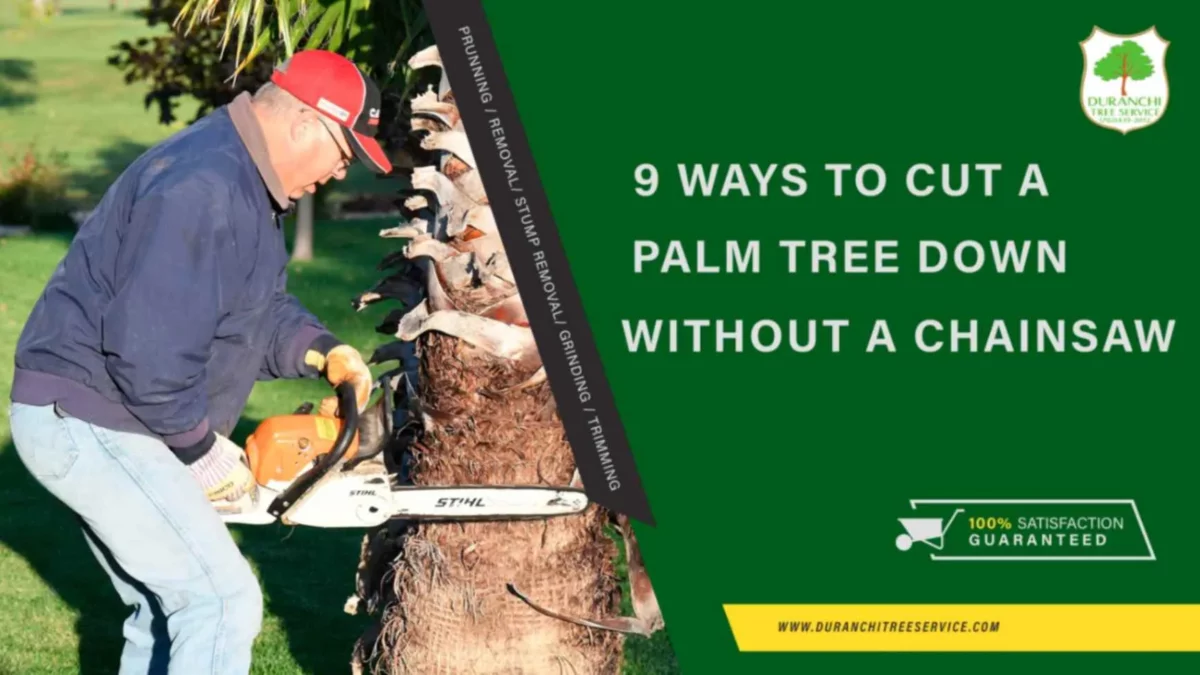
9 Ways to Cut a Palm Tree Down Without a Chainsaw
When it comes to palm tree removal, many people immediately think of chainsaws. However, sometimes, you don’t have a chainsaw at your disposal, or maybe you’d prefer techniques that are less noisy or intimidating. In these cases, there are plenty of other methods of removing palm trees.
Assessment and Planning
First things first, you need to assess the situation to decide on the best method. Consider the size of the palm, its location, and what potential hazards it may create when it comes down. It’s crucial to plan an escape route just in case the tree doesn’t fall as expected. This is a highly important part of the safety tips for DIY tree removal.
Hand Tools for Palm Tree Removal
You’d be amazed to know the range of hand tools for palm tree removal at your disposal. Axes, handsaws, pole pruners, or even just a high-quality machete could all work.
Step-by-Step Guide to Cutting a Palm Tree
Here’s a basic step-by-step guide to cutting a palm tree:
- Gear Up: Always wear appropriate protective clothing, like gloves, sturdy boots, and safety glasses.
- Clear the Area: Ensure there are no objects or people within the area where the palm tree could fall.
- Cutting: Start by creating a notch on the side of the tree facing the direction you want it to fall. Then, cut from the other side, slightly above the initial notch, ensuring you don’t cut all the way through.
- When the tree starts leaning, step back and let it fall.
Natural Ways to Remove Palm Trees
If you’re interested in natural ways to remove palm trees, using salt can be a great option. By drilling holes into the tree and filling them with salt, you can cause the palm to become dehydrated and die over time.
DIY Methods and Tips
There are various DIY tree removal methods that you can use. One of the easiest methods involves using a wedge and hammer to split the tree until it topples. Remember always to plan and assess the situation before trying any DIY tree removal.
Safety Tips for DIY Tree Removal
Safety should always be your top priority during any DIY tree removal. Always wear protective gear, clear the area, and establish an escape route. Remember, if the tree is too large or near power lines, it’s safer and wiser to call a professional.
Alternative Tools for Tree Cutting
The variety of alternative tools for tree cutting is always expanding. Bow saws, loppers, hatchets, and even simple handsaws can all be effective when removing a palm tree.
Disposal and Cleanup
Once the tree is down, the job isn’t over. Proper disposal is critical, whether that means chopping the tree into firewood, taking it to a local recycling center or composting, if your municipal guidelines allow.
In conclusion, non-chainsaw methods for cutting trees offer affordable and accessible solutions. With the right tools, enough caution, and a bit of elbow grease, your palm tree can be safely removed without a chainsaw. However, safety always comes first, so if a job is too big, it’s always best to call a professional.
Frequently Asked Questions (FAQs)
You can use a variety of hand tools such as axes, handsaws, pole pruners, machetes, or even loppers. Just make sure the tool you choose is suitable for the size and situation of your tree.
One natural method is to use salt, by drilling holes into the tree and filling them with salt, which can cause the palm tree to become dehydrated and die over time. Another option is to utilize biological control, like introducing specific insects that target palm trees.
Always wear appropriate protective gear such as gloves, sturdy boots, and safety glasses. Clear the area where the tree could fall, and make sure to have an escape route planned in case things don't go as expected.
If the palm tree is too large, unstable, or near power lines, it's best to call a professional to ensure safety and prevent property damage. Professionals have the experience, tools, and knowledge to carry out the job safely and efficiently.
Proper disposal includes chopping the tree into firewood, taking it to a local recycling center, or composting (if allowed by your municipality). For clean-up, make sure to remove any remaining debris from the area and ensure the job site is safe.



